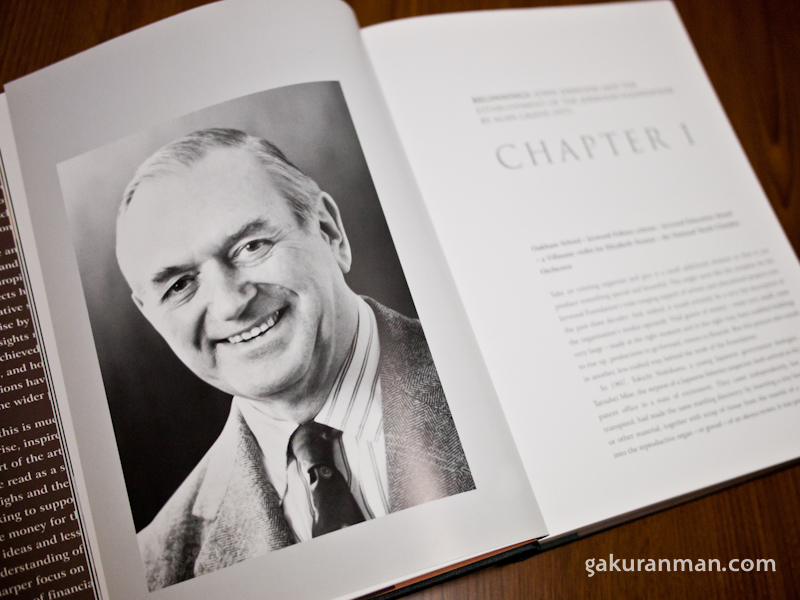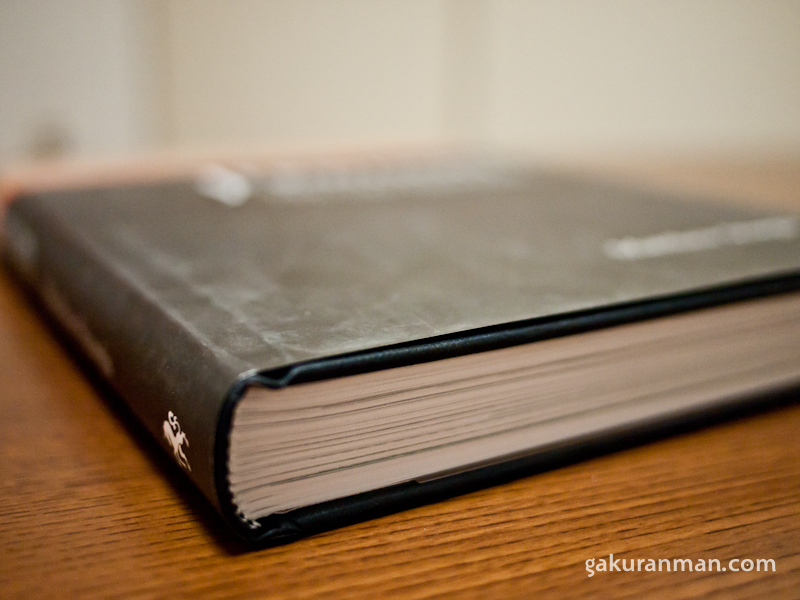The book I ordered from the U.K finally arrived. With this, I wanted to consolidate some of the information I’d dug up on the internet and hopefully find some fresh leads of the Japanese family that our rich pearl dealer Mr. J married into. Parts 1, 2 and 3 of the story so far.

Alas, the book about Mr. J and his Foundation, although confirming a lot of what I thought, does not bring much new information to the table. I scoured the index for any Japanese names and read through the opening chapters about his life. The remainder of the book is focussed entirely on the Foundation’s growth and achievements. I am very disappointed that Mr. J’s personal life and business in Japan was neglected. The book says absolutely nothing about the family he married into, save for one clue which I already had – that his wife was the daughter of a consulate official. It did contain a picture though, as you can see above. It matches the one found in the house, so there’s no remaining doubt that we’ve solved the mystery of his identity.
Anyway, here are the useful points, verbatim from the book. I’ve changed the names to initials where necessary.
And it was to Japan that the twenty-nine year old Mr. J went in 1947. … Mr. J remained based in Japan for the rest of his remaining life. He embraced Japanese culture and mastered Japanese business. He learnt the language. And in 1950 he married Miss. S.K, whom he had first met some fourteen years earlier. (She was the daughter of a Japanese consular official). And, in time, he built up one of the largest cultured pearl dealerships in the world. It was an impressive achievement, and one grown from modest beginnings.
(p15)
So with this, we know for sure when he left for Japan, when he married and who his wife was. Good stuff.
The uncle who ran the jewellery business died early in 1948, and Mr. J … made the bold decision to move to Japan, to set up his own there in the pearl trade. It was a decision that in time – and after much hard work – paid rich dividends.
Mr. J, however, was never a blinkered slave to commerce. He was a man of diverse interests. He loved horse racing and enjoyed the arts. He was well read, retaining always a special admiration for the genius of Shakespeare. And although he remained based in Tokyo, he and his wife (they had no children) travelled extensively in Europe, America and Asia.
(p17)
A bit of new information here. We learn just a touch about Mr. J and his interests. Also, we confirm that he had no descendants and travelled *with* his wife abroad extensively. This is important because there was speculation on the Japanese message boards that his wife may have been largely neglected and confined to the Hotel Okura. Of course, she still may well have been in her day-to-day life – we can’t yet be sure – but this book says she at least went on trips with him.

Mr. J … died unexpectedly in New York in 1991.
(p29)
Mr A.G … became an ‘independent director’ of five or six companies, both listed and private, amongst them Mr. J’s international pearl-trading business. … But with Mr. J’s death, matters became more urgent and concentrated. Mr. J, during his life, had provided that all his resources should – at his death – pass to the Foundation, and Mr. G found himself charged with the business of seeing this carried out. It was a huge undertaking.
‘The first task,’ Mr. G recalled, ‘was to gather in the money: to track it down and to recover it.’ Although Mr. J had in fact sold his original company to its long-serving Swiss manager at the end of the 1980s, he had continued to trade and deal independently as a sole trader. By the time of this death his interests and his assets were once more scattered over five continents, The process of recovering the J fortune took the best part of three years to complete, but in the end was almost entirely successful. The was only one bad debt, in Hong Kong.
(p32)
Finally, we confirm the date of Mr. J’s death and also the location. New York..? That’s a surprise to me. And even moreso that it was ‘unexpected’. Perhaps a heart attack?
Also of interest to me are the words ‘all his resources should – at the time of death – pass to the Foundation’. What does this mean? Did Mr. J abandon his family and in-laws and donate his entire fortune to the Foundation he created? Is this the cause of the summer retreat/K-house falling into disrepair and becoming a haikyo? What became of his widow and her family after he died?
Questions, questions. We cannot say for sure that he left them with nothing. Perhaps his donations to them were omitted from the book for brevity or because of their personal nature. One thing is on my mind though. Does this somehow connect to the ominous words of Kaede-san, the Japanese blogger who first wrote about the Royal House?
ただ、ネットでは全く情報もなく図書館やら行って調べました。
調べていくうちに知らない方がよかったことも知ってしまったような感覚になりました。
Translated:
But because there was no information on the internet, I went to the library to research. While there, I felt that I’d learned something I’d prefer not to have known.
He has since removed the pages he posted about the haikyo, which is strange. But here’s the link for posterity anyway. Perhaps he learned that the family were thrown into disarray from Mr. J’s sudden death and loss of financial support..? It’s still just a theory.
Well then, now all that remains is the mammoth task of figuring out just who the K family were and what happened to their house. Hmm…









I stumbled on your page purely by accident (a pop up ad) while reading an article in one of the online news sites. I found it intriguing, being stationed on Okinawa for an accumulative 5 years. I had the opportunity explore some of the Haikyo sites there. Your story on the Royal House, I found it intriguing and want to wish you the best of luck in bringing this to a beneficial closure. Thanks for sharing what you found, and keep up the good work.
Thanks for the comment! Not sure what my site was doing in a pop-up, but I’m glad you made it! Stay tuned for more haikyo stories in the future :).
i manage to dig up the link and it sad
it sound sad after translating using google translate (due to bad translation)
hello, so i found the foundation and can’t understand why a foundation that has millions of pounds to give away could not take care of what was an important part of this man’s life?
Fascinating study, beautiful images. I admire your discretion. Found Mr. J; not too difficult, as you said. Wonderful foundation. From the appearance of at least one of the rooms in the Royal House, it looks like relatives began sorting things after the lady’s death. It looks sad, but I’m not sure it’s terribly unusual when there’s a big gulf between generations, in Japan or in Europe/US. In Japan it may have been a bit less proper to fight publicly for inheritance, so perhaps it didn’t occur to more distant relatives to stake a claim to the house. Looking forward to your future research!
Good to know you found him Sarah :). I think we’re on the verge of some exciting new discoveries, so keep your eyes peeled over the coming weeks!
I have this eerie feeling that after you’ve gathered everything about this mystery house and family, you’ll suddenly disappear. Most likely by someone putting a bag over your head, dragging you into the back of a windowless van and then driven off a cliff.
My my! I certainly hope that doesn’t come true o.O;. Perhaps there is a sinister truth behind all this that I shouldn’t come to know. But I’m a little more skeptical ;). What does interest me greatly is whether or not there are any relatives still living. Perhaps they have simply forgotten about this place?
Is it at all possible, do you think, that this couple had a falling out, leaving the house forgotten (perhaps with bad memories?) and in disarray after Mr. J’s death? My other guess would be that it wasn’t willed to Mrs. K’s family, so it remained in the state its in. I’ve always been interested in the haikyos that look like the owners hurriedly packed a few things, dug through a bunch of others, and simply left with what they could carry. My guess is also that if there are any living relatives, they probably don’t even know this house exists, especially since the couple didn’t have any children, and more than likely the house belonged to Mr. J…
So many speculations!
That’s an interesting theory Charlotte. I think that the house was probably registered in a member of the K family’s name though, since all the mail was registered to them and Mr. J and his wife primarily lived in Tokyo near the Hotel Okura. However, it could have been that Mr. J paid for the various expenses on the house and since his death it fell into ruin. That doesn’t explain why the last calender on the wall of the house read 1988 though, 3 years before Mr. J’s sudden death…
Hmmm that’s a good point about the mail. As for why the calendar stops at 1988… that’s another interesting mystery. It did seem like there was some shuffling around in the house before it was abandoned, but whether that was from the owners, or other, less conscientious explorers, I couldn’t say. You’ve definitely got the better experience so I’d defer to your judgments!
I think you are right that relatives have visited this house since the death of Mr. J (and quite likely Mrs. K too). Everything is neatly piled up and there are far more items than usual in the rooms – they were probably moved from Hotel Okura when the house became disused. When that was though – that is the mystery…
come on. just tell us who this Mr J is.
There are plenty of clues left around in my posts that can be followed to find out :). I don’t want to mention the name directly here, at least not yet.
Why do you not want to reveal who it is just yet? To keep us reading? :P
Or are you afraid you could get in trouble if you are wrong?